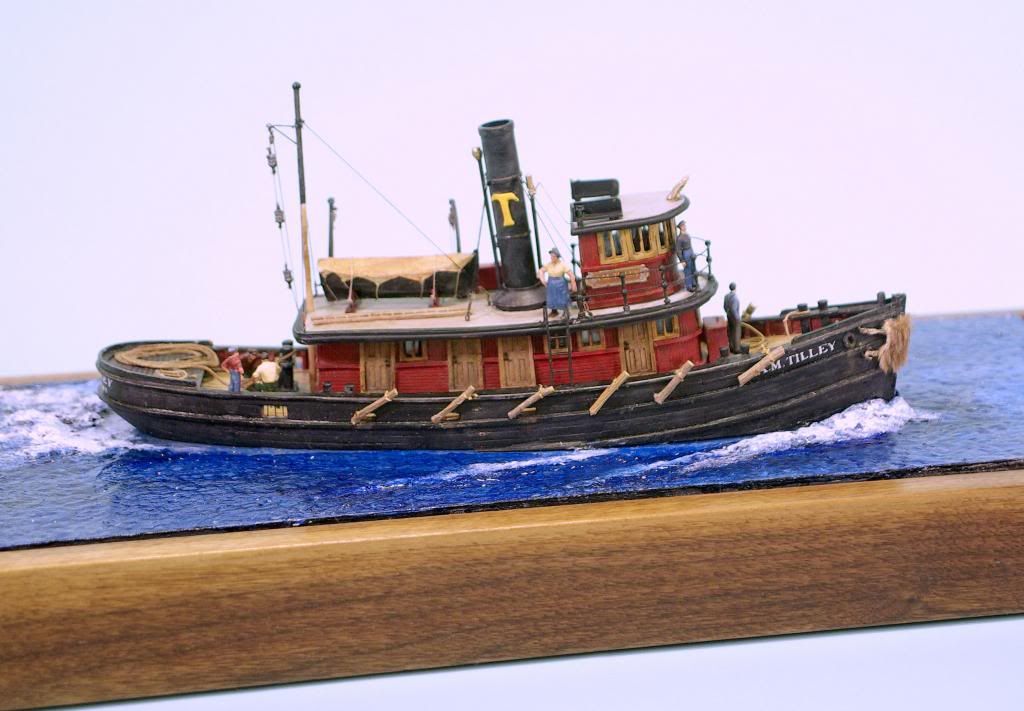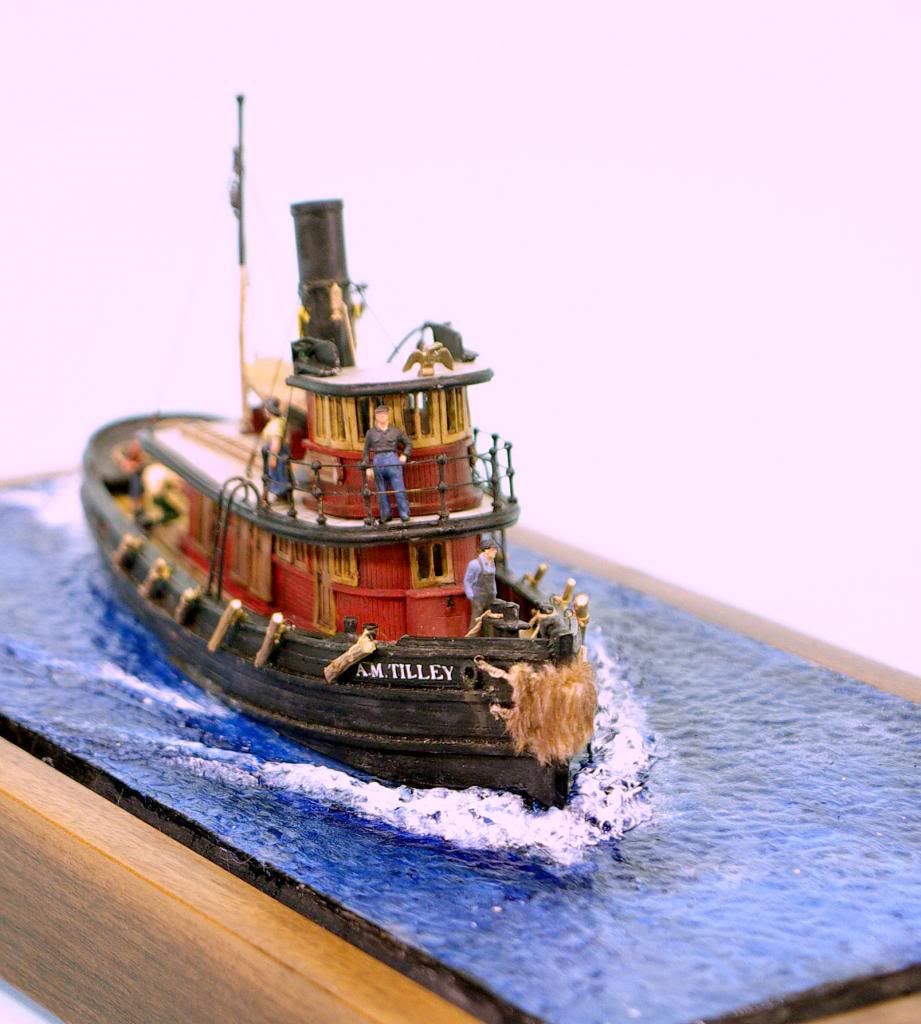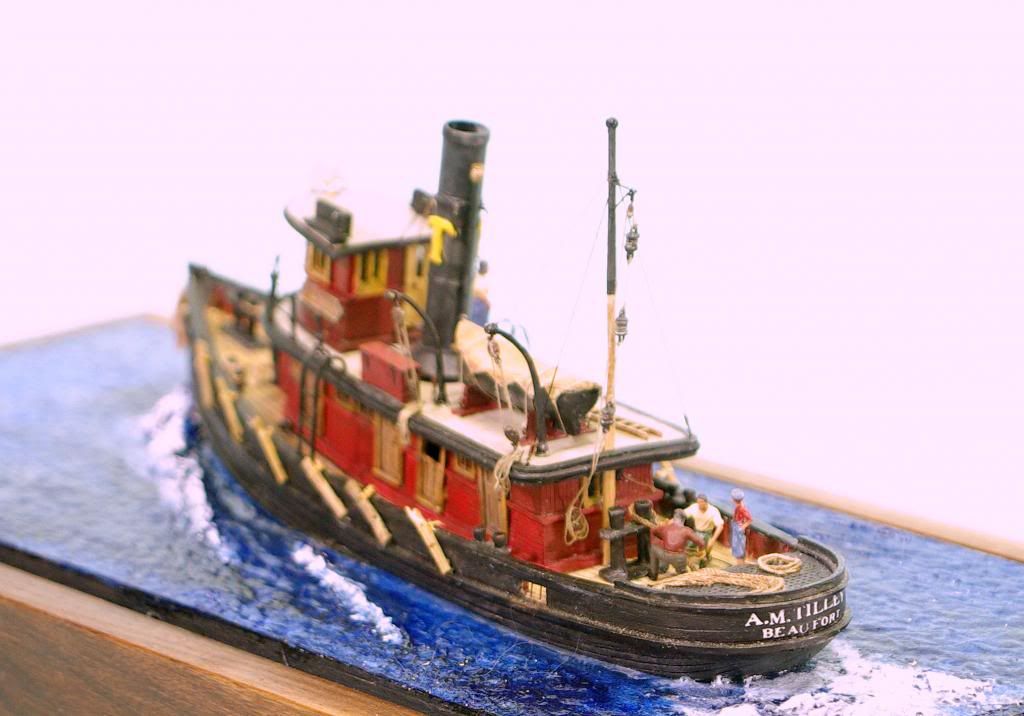
A few pictures of another one of my models, this one an entirely fictitious harbor tug from around 1900. It's based on the Model Shipways Taurus kit. The plans in that kit don't represent any actual tug; they're derived from several boats that existed in that time period. I've always liked it as a great representation of the classic tug shape. So I figured the sky was the limit on names and color schemes. I named her after my dear wife, Anne, and gave her the highly unlikely home port of Beaufort, North Carolina. (Our ship model club meets at the NC Maritime Museum there. Meetings the last Saturday of every month, September through May; new members and guests always welcome.)
The kit has a machine-carved basswood waterline hull with the main deckhous carved in place, and cast britannia fittings. I chiseled off the deckhouse and built a new one from Evergreen scribed plastic sheet. After chiseling the bulwarks down as thin as I could, I planked the hull exterior and the deck with strips of holly veneer (cut on my Microlux miniature table saw). The pilothouse is also made from scribed styrene. The windows are castings from the kit; the stack is brass tube, with the bands added from tubing of the next size up. (The kit contained a rough wood dowel for the purpose; that seemed pretty pointless.)

The fender on the bow is made from a catnip mouse that I found in a pet store. (My two cats, Yehudi and Hepzibah, just about went crazy over this model until it got shut up in its case - which apparently is smell-proof.) The kit is on HO scale (1/87), so I took that as an invitation to make use of parts from the hobby shop's railroad department. The steam whistle on the stack was intended to go on a steam locomotive. The figures came from the extensive German Preiser line - repainted of course. My wife insisted that there be a big, Tugboat Annie-type woman on board. I've gotta open up the case and adjust the pose of that guy standing in front of the pilothouse; he's leaning over backward.
The side fenders, which would be made of logs in reality, were cut from twigs off a holly tree in our front yard.

On the afterdeck two sailors are showing an apprentice how to turn a splice in a tow cable. The cast metal stern grating was pretty crude, so I replaced it with one made up from Model Expo's boxwood grating strips.
The cat sleeping on the pilothouse step, waiting to trip somebody, is painted in the authentic Siamese/Himalayan markings of Yehudi. The lettering on the hull is made up from Woodland Scenics dry transfers. The ladders leading from the maindeck to the deckhouse roof are plastic castings intended for boxcars.
The boat on the deckhouse roof is based on the casting in the kit, but its gunwales were too low for the scale. (I think the boat was originally intended for a model on a smaller scale.) So I stuck some hunks of sheet styrene on top with CA, and carved and sanded them to shape. The boat cover is made from my old favorite sail material, lens tissue coated with PollyScale paint mixed with white glue. The few rigging blocks are britannia castings from Bluejacket. The ladder lying on the deckhouse roof came from a Jordan Miniatures HO firetruck.
The basis of the water is carved with a spoon gouge from poplar, primed with gesso, and painted with artists' acrylics. The wake and bow wave were added with Woodland Scenics "Water Effects," and the whole base was coated with Windsor and Newton gloss acrylic varnish. The rim of the base is walnut. The clear plastic vitrine (not shown in the photos) came from an A.C. Moore's arts and crafts store.
This was a fun little project. Building a fictitious vessel obviously liberates the modeler from the ordinary constraints of research; I studied dozens of tug photos in books and picked the features I liked. I can only recommend the kit with some pretty big reservations, but I'm pretty satisfied with the results - and so is my wife. Pretty soon I'm going to build a generic Gloucester fishing schooner and name it after my father.
If anybody's interested in tackling this kit, the time to buy it is now. Model Shipways says it's in the process of phasing it out. I do hope somebody releases something similar; the ship modeling world just wouldn't be the same without a nice little wood tug like this.
Thanks for looking.